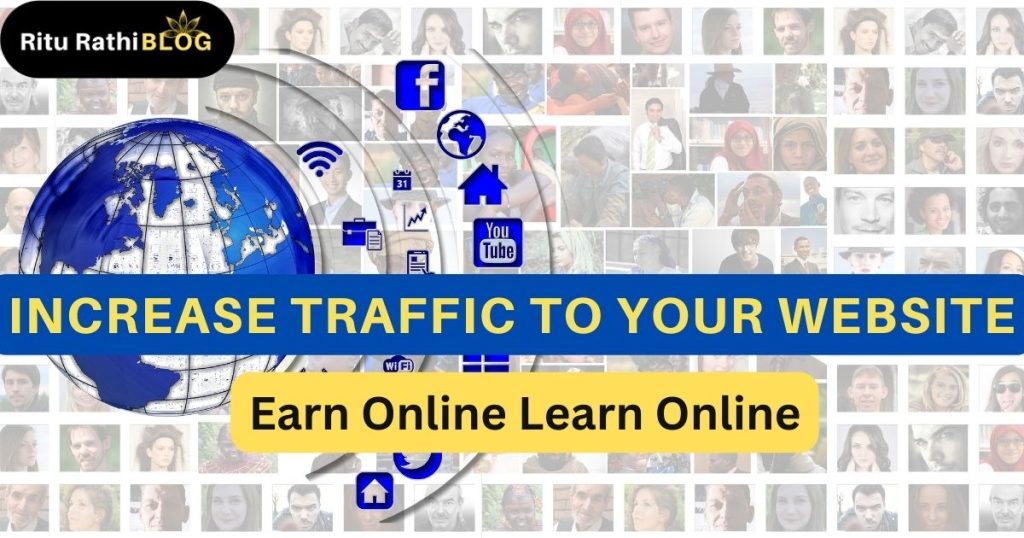Driving website traffic is crucial for any business or individual looking to establish a strong online presence. While creating a visually appealing website with valuable content is important, it’s equally crucial to ensure that your website receives a steady flow of traffic.
By increasing traffic to your website, you can boost your online visibility, expand your reach, and increase your chances of converting visitors into loyal customers. Fortunately, there are numerous proven strategies that can help you increase website traffic.
In this article, we will explore 10 of the most effective techniques that can help you increase your website traffic in 2023, but before that you need to understand more about the website, so Let’s start :

How to make website ?
Step- 1 : Choose a domain name
When choosing a domain name, it’s important to consider the following:
Make it easy to remember: Choose a domain name that is easy to remember and spell, and avoid using hyphens or numbers that can confuse people.
Keep it short: A shorter domain name is easier to remember and type.
Make it relevant: Choose a domain name that reflects the purpose of your website and the content you plan to publish.
Avoid trademark infringement: Make sure your domain name doesn’t infringe on any existing trademarks or copyrights.
Consider the extension: There are many different domain extensions available, such as .com, .org, and .net. Consider which one is most appropriate for your website.
When it comes to choosing a domain name registrar, there are many options available. Some of the most popular platforms for purchasing domain names include:
GoDaddy: This platform is one of the most popular for buying and managing domain names.
Namecheap: This platform offers affordable domain name registrations and renewals, as well as a user-friendly interface.
Bluehost: This platform is a web hosting provider that also offers domain name registration.
Google Domains: This platform offers simple domain registration, easy domain management, and domain privacy.
HostGator: This platform offers domain name registration, web hosting, and website building services.
When choosing a platform, consider factors such as price, customer support, and ease of use.

Step- 2 : Select a hosting provider
When choosing a hosting provider, it’s important to consider the following:
Type of hosting: There are different types of hosting available, such as shared hosting, VPS hosting, dedicated hosting, and cloud hosting. Choose the one that suits your needs and budget.
Server uptime and reliability: Look for a hosting provider that offers at least 99% server uptime and reliable performance.
Customer support: Choose a hosting provider that offers good customer support, such as 24/7 phone, email, or chat support.
Security: Look for a hosting provider that provides good security measures to protect your website and data.
Bandwidth and storage: Choose a hosting provider that offers enough bandwidth and storage for your website’s needs.
Some popular platforms for hosting are:
Bluehost: This platform offers affordable shared hosting plans with good uptime and customer support.
HostGator: This platform offers a variety of hosting plans, including shared, VPS, and dedicated hosting.
SiteGround: This platform offers managed WordPress hosting, as well as shared, cloud, and dedicated hosting plans.
DreamHost: This platform offers shared, VPS, and dedicated hosting plans with good uptime and customer support.
InMotion Hosting: This platform offers shared, VPS, and dedicated hosting plans with good uptime and customer support.
When choosing a hosting platform, consider factors such as price, performance, customer support, and security features. It’s also a good idea to read reviews and compare different options before making a decision.

Step- 3 : Choose a website builder or CMS
When choosing a website builder or content management system (CMS), it’s important to consider the following:
Ease of use: Choose a website builder or CMS that is easy to use, especially if you don’t have much experience with web design or coding.
Features and customization options: Look for a platform that offers the features and customization options you need for your website, such as templates, drag-and-drop editors, and plugins.
Scalability: Choose a platform that can grow with your website as it expands and requires more features.
Support and community: Look for a platform that has good support and a strong community, as this can be helpful if you run into problems or have questions.
Some popular platforms for website builders and CMS include:
WordPress: This is a free and open-source CMS that is widely used and offers a lot of customization options and plugins.
Wix: This is a popular website builder that offers drag-and-drop functionality and a variety of templates.
Squarespace: This is a website builder that offers a range of templates and customization options, as well as built-in SEO and analytics tools.
Shopify: This is an e-commerce website builder that is designed specifically for online stores.
Joomla: This is a free and open-source CMS that is known for its flexibility and scalability.
When choosing a website builder or CMS platform, consider your specific needs and goals for your website. Read reviews, compare features, and try out demos or free trials to find the platform that works best for you.

Step- 4 : Design your website
When designing your website, it’s important to consider the following:
Purpose and audience: Determine the purpose of your website and who your target audience is. This will help you design a website that is relevant and appealing to your visitors.
Navigation and structure: Make sure your website has a clear and organized structure, with easy-to-use navigation that allows visitors to find what they’re looking for quickly.
Visual design: Choose a color scheme, typography, and imagery that reflect your brand and appeal to your audience. Make sure your design is visually appealing and easy to read.
Mobile responsiveness: Ensure that your website is mobile-responsive, meaning it displays properly on different screen sizes and devices.
Page speed and performance: Optimize your website’s loading speed and performance to improve user experience and search engine rankings.
Accessibility: Make sure your website is accessible to all visitors, including those with disabilities. This includes using alt text for images, providing captions for videos, and ensuring a high level of color contrast.
Content: Make sure your website has high-quality, relevant, and engaging content that provides value to your audience.
Security: Protect your website and visitors by using HTTPS encryption, regular backups, and strong passwords.
Call to action: Make it clear what you want visitors to do on your website, whether it’s filling out a form, making a purchase, or contacting you.
When designing your website, it’s important to keep your audience and goals in mind. Don’t be afraid to ask for feedback from others, and continually test and refine your design to improve its effectiveness.

Step-5 : Create your website’s pages
When creating pages for your website, there are a few key elements to keep in mind.
Here are some general guidelines for creating effective website pages:
Clear and concise headings: Each page on your website should have a clear and concise heading that accurately describes the content of the page.
Well-organized content: Break up your content into smaller, easy-to-read sections. Use bullet points, subheadings, and images to help break up text and make your content more readable.
Call-to-action: Each page should have a clear call-to-action (CTA) that encourages visitors to take a specific action, such as filling out a form or making a purchase.
Mobile responsiveness: Ensure that your website pages are mobile responsive, meaning that they are optimized for viewing on mobile devices such as smartphones and tablets.
Step- 6 : Add content to your pages
Content is a crucial component of a website as it not only informs and engages visitors but also helps to improve search engine rankings. Here are some tips on how to generate SEO-friendly content:
Conduct keyword research: Research keywords related to your business or niche and use them in your content. Use keyword research tools to find popular keywords and phrases related to your industry.
Use descriptive and concise headings: Use headings and subheadings to break up your content and make it easier to read. Use descriptive and concise headings that accurately describe the content of each section.
Write for your audience: Write content that is useful, informative, and engaging for your target audience. Consider their needs, preferences, and interests when creating content.
Avoid keyword stuffing: While it’s important to use keywords in your content, avoid overusing them. Keyword stuffing can harm your website’s search engine rankings, as search engines penalize websites that engage in this practice.
Use internal linking: Link to other pages on your website using relevant anchor text. This can help improve website navigation and encourage visitors to stay on your website longer.
Optimize meta descriptions: Write descriptive meta descriptions that accurately describe the content of each page. Use keywords in your meta descriptions to help improve search engine rankings.
Use images and videos: Use high-quality images and videos to enhance your content and make it more engaging. Optimize images by compressing their file size and using descriptive filenames and alt text.
By following these tips, you can generate SEO-friendly content that will help improve your website’s search engine rankings and attract more visitors. Remember to create high-quality, useful, and engaging content that provides value to your audience.

Step- 7 : Install necessary plugins
Must have Plugins for website :
Rank Math: This plugin helps you optimize your website’s content for search engines by providing suggestions for improving your content’s readability and keyword optimization.
Jetpack: Jetpack provides a suite of tools to help you manage your website, including security features, site statistics, and social media integration.
Contact Form 7: This plugin allows you to create custom contact forms that visitors can use to get in touch with you directly from your website.
WP Super Cache: This plugin helps improve the speed and performance of your website by caching your pages and reducing server load.
Akismet: Akismet is a spam protection plugin that helps prevent unwanted comments and messages from appearing on your website.
Instant Indexing : By using an instant indexing plugin, website owners can potentially increase their website traffic and visibility, as their content will be available in search results more quickly. However, it’s important to note that search engines have their own algorithms for determining which content to index and rank, so using an instant indexing plugin is not a guarantee of improved search engine rankings.
Remember to only install plugins that you actually need and regularly use, as having too many plugins can slow down your website’s performance.

Step- 8 : Test your website
Here are some steps you can take to test your website after installing plugins:
Check for plugin conflicts: After installing a new plugin, test your website to ensure that it is still functioning properly. Check for any plugin conflicts that may have arisen as a result of the new plugin.
Test website speed: Use a website speed testing tool to test the speed of your website. Slow website speeds can negatively affect user experience and search engine rankings.
Check for broken links: Use a broken link checker tool to check for broken links on your website. Broken links can harm your website’s search engine rankings and create a poor user experience.
Test website security: Use a website security testing tool to test the security of your website. Ensure that your website is secure and protected from potential threats.
Test website responsiveness: Test your website’s responsiveness on different devices and screen sizes, such as smartphones, tablets, and desktops. Ensure that your website is responsive and provides a good user experience on all devices.
Perform a user experience (UX) test: Test your website’s UX by having users navigate your website and provide feedback. This can help identify areas for improvement and enhance user satisfaction.
By taking these steps to test your website, you can identify any issues and address them promptly. This will help ensure that your website is functioning properly and providing a positive user experience for your visitors.
Step-9 : Launch your website
Once you’re satisfied with your website, launch it and start promoting it to attract visitors and grow your online presence.
Step- 10 : Maintain and update your website
Regularly update your website with fresh content and security updates to keep it relevant and secure
Once you launch your website you can also start earning from your website and for this you have 9 Proven ways to earn from your website
10 Proven Ways to Increase Your Website Traffic in 2023
Understand two essential questions before learning 10 proven ways of increasing website traffic. Once answered, the third point on driving website traffic can be better understood.
1. What is Website Traffic?
Website traffic refers to the number of visitors who access a website and view its pages. This includes both organic website traffic (visitors who find your website through search engines) and referral traffic (visitors who come to your website from other websites or social media platforms).
2. What are the sources of website traffic?
Here are some common sources of website traffic:
Organic search traffic: Visitors who find your website through search engines like Google, Bing, and Yahoo.
Direct traffic: Visitors who directly type your website’s URL into their browser or use bookmarks to access your website.
Referral traffic: Visitors who come to your website from other websites or social media platforms. This can include backlinks, social media shares, and mentions in online forums and communities.
Paid search traffic: Visitors who come to your website through paid search advertising on search engines like Google Ads.
Social media traffic: Visitors who come to your website through social media platforms like Facebook, Twitter, and Instagram.
Email marketing traffic: Visitors who come to your website through email marketing campaigns such as newsletters and promotional emails.
By understanding the sources of website traffic, you can focus on optimizing your strategies for each source to drive more website traffic and improve your online presence.
3. 10 Proven Ways to Increase Your Website Traffic in 2023
Sure, here are 10 proven ways to increase your website traffic in 2023:
Optimize your website for search engines: Use SEO best practices to optimize your website for search engines. This includes conducting keyword research, optimizing your content and meta tags, and building high-quality backlinks.
Create high-quality, shareable content: Create high-quality, informative content that provides value to your audience. Make sure your content is shareable by including social sharing buttons and encouraging readers to share.
Use social media: Use social media platforms to promote your content and engage with your audience. Share your content on social media and interact with your followers to build relationships and drive website traffic .
Utilize email marketing: Use email marketing to build a list of subscribers and drive website traffic. Send regular newsletters, promotions, and updates to your subscribers to keep them engaged and interested in your content.
Collaborate with other websites and influencers: Collaborate with other websites and influencers in your industry to reach a wider audience and drive website traffic. This can include guest blogging, cross-promotion, and influencer marketing.
Utilize paid advertising: Use paid advertising platforms such as Google Ads and social media advertising to drive targeted website traffic. Make sure to optimize your ads for maximum effectiveness and ROI.
Host webinars and live events: Host webinars and live events to engage with your audience and promote your website. Offer valuable insights and information to attendees and include calls-to-action to drive website traffic .
Use video marketing: Use video marketing to promote your website and engage with your audience. Create informative and entertaining videos that provide value to your viewers and include calls-to-action to drive website traffic.
Optimize your website for mobile devices: With the increasing use of mobile devices, it’s essential to optimize your website for mobile users. Make sure your website is responsive and mobile-friendly to provide a seamless user experience.
Monitor your website traffic and adjust your strategies accordingly: Use analytics tools to monitor your website traffic and adjust your strategies accordingly. Identify what’s working and what’s not, and make changes to optimize your website traffic and conversions.
By following these proven methods, you can increase your website traffic and build a strong online presence in 2023. Remember to focus on providing value to your audience and continually optimizing your strategies for maximum effectiveness.
****Thanks for reading and enjoy reading our other recent blogs****
- Popular Hostinger Hosting Pricing and Complete Review
- Discover the Top 7 Hosting Providers in the USA
- Best PebbleHost Server: For High-Performance Minecraft Gaming
- 15 Reasons: Why is consistency in content creation is important?
- 6 Best End of Tenancy Cleaning in London
Disclaimer
The information provided in this blog is intended for educational and informational purposes only. While we make every effort to provide accurate and up-to-date information, we cannot guarantee the accuracy or completeness of the information presented. The views and opinions expressed in this blog are those of the authors and do not necessarily reflect the official policy or position of any organization or entity. Please use the information presented in this blog at your own discretion and consult with a professional for any specific questions or concerns.
